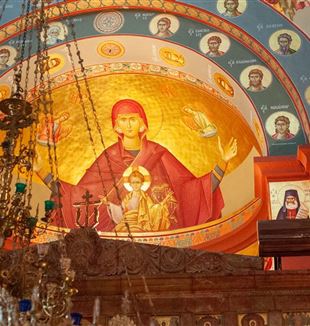
Russians and Ukrainians pray together for peace
The Eurasian CL communities joined together for a moment of song and prayer, following the Pope's intention. "In such a delicate moment, our gaze must be turned towards the person of Christ.”Ukrainians and Russians together. But also Belarusians, Kazakhs and Lithuanians. The Eurasian CL communities connected via Zoom for a moment of prayer for peace following the intention expressed by Pope Francis at last Sunday’s Angelus.
A simple moment of songs and prayers, also from the Russian Orthodox tradition, to which several of the participants belong. Led by Jean François Thiry, regional manager, it brought together about seventy people while, at the same time, a similar gesture had been organized, in Italian, by Russian Cristiana.
After the reading of the words pronounced by the Pope on Sunday, there was the recitation of the Angelus and the reading of the prayer for universal brotherhood proposed in the encyclical Fratelli tutti: "Come, Holy Spirit! Show us your beauty / reflected in all the peoples of the earth, / so that we may discover anew/ that all are important/ and all are necessary/ different faces of one humanity that God so loves." The first song, then, was a song to Our Lady, Mater nebo, written by an Orthodox girl of the movement: "Mother of light and love, our people are gathered before you, we beg you: our misfortunes are endless. (...) Star that guides us, never abandon us, turn your tender gaze upon your children on their way and show us the way.”
The prayer of Metropolitan Antonij of Suroz, to whom many of the Orthodox present are attached and to whom they dedicated a large exhibition at the Rimini Meeting in 2015, was then read: "Lord, I cannot live without You! / I am so fragmented, disunited in myself, disunited with my neighbor, / I do not live the unity of charity with all those around me, / because I am not united to You! / Unite me to you so closely, so perfectly, / like the twig grafted onto the tree that gives it life unites to it. / Give us to be one with you, Lord, / so that your life may flow back into us, your divinity pervade us, your holiness fill us, your purity becomes our purity."
Then another song was sung to Our Lady, this time Reina de la Paz by Claudio Chieffo: "Mother of Love, the lie destroys me. I want to be here, watch over me, I need your comfort." Then another prayer by a great figure of the Orthodox world, Father Aleksandr Men: "Give us to fulfill your new commandment, so that we may love one another as you have loved us. Give us patience, benevolence and dominion over one another, that we may be one as You are one with the Father and the Spirit, according to Your prayer and commandment."
A passage from Fr. Giussani's Generating Traces in the History of the World was then proposed: "The ‘I-You’ relationship between Christ and me is a relationship that carries my whole self in it, and therefore carries in me all those who share in Christ, as they were one (...). With Baptism was born a new personality which, the more it becomes aware of other human beings also called by Christ, the more it feels one with them ‘Don’t you know you are members one of another?’) Love for others becomes an overwhelming passion for them because they are part of Christ and therefore part of me. Thus is the new constellation that guides the sky which is God’s Holy Church. Thus arises a true reality of communion that begins and spreads as a whole subject of society, of the world, of human history, of universal history – the Church as the Body of Christ". The moment of prayer concluded with the recitation of the Our Father and the ancient Slavic song Pod tvoju milost' (Sub tuum praesidium).
"It was a gesture designed to remind us that, in such a delicate moment for the history of our countries, our gaze must be turned towards the person of Christ," explains Jean François Thiry. “And that we must entrust ourselves to the protection of Our Lady.”
This is not the first time that the CL communities in these countries have joined together to remind themselves of what is the true source of peace. It had already happened in 2014, the year of the Maidan Square riots, the events in Crimea and the beginning of the clashes in Eastern Ukraine, when a pilgrimage to the Holy Land was organized, to which Catholics and Orthodox, Russians and Ukrainians participated.